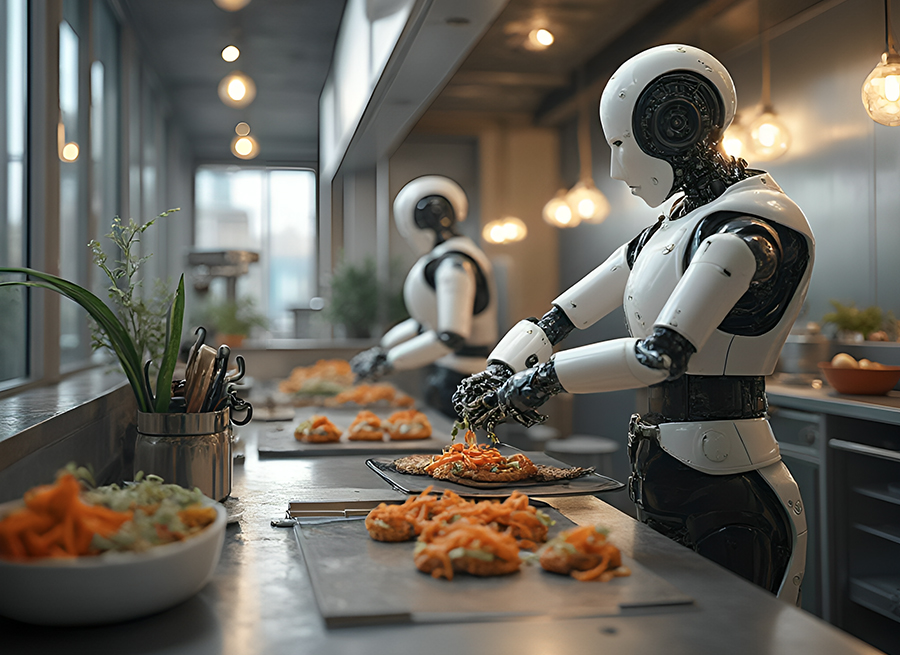Introduction to robot chefs and their implementation in restaurants
Imagine walking into your favorite restaurant and being greeted not by a friendly server, but by a sleek robot chef expertly preparing your meal. This may sound like something out of a sci-fi movie, but it’s quickly becoming reality as AI in restaurants takes the culinary world by storm. With advancements in kitchen technology, many establishments are embracing robot chefs to enhance their dining experience. But is this innovative trend merely a gimmick or could it truly be the future of dining? Join us as we explore the fascinating rise of robot chefs in restaurants and what it means for food lovers everywhere.
Advantages of using robot chefs
Robot chefs bring precision to the kitchen. They can measure ingredients accurately and replicate recipes consistently. This ensures that every dish meets high standards.
Efficiency is another significant advantage. Robot chefs work tirelessly, preparing meals faster than human hands ever could. Busy kitchens benefit from this speed, especially during peak hours.
Cost savings are also noteworthy. While initial investments in robot technology might be steep, reduced labor costs over time often balance it out. Restaurants can allocate resources differently without compromising on quality.
Furthermore, robot chefs enhance food safety by minimizing human contact with ingredients. With automated processes, the risk of contamination decreases significantly.
Integrating AI into cooking allows for innovative culinary creations that traditional methods may not achieve easily. Chefs can experiment with new techniques while robots handle repetitive tasks seamlessly.
Disadvantages of using robot chefs
One of the primary concerns with robot chefs is their inability to replicate human creativity. Cooking often involves a personal touch, intuition, and experimentation that machines can struggle to emulate.
Additionally, maintenance and repair costs can be a burden for restaurant owners. When technology malfunctions, it may lead to interruptions in service or even loss of income.
Robot chefs also face limitations with complex dishes requiring delicate techniques. Certain culinary tasks require finesse that robots have not yet mastered.
Customer experience could suffer as well. Diners might miss the warmth of interactions with passionate human chefs who share stories behind each dish.
There’s an ongoing debate about job security in the culinary field. The integration of robots raises questions about opportunities for aspiring cooks and seasoned professionals alike.
Real-life examples of restaurants using robot chefs
Several innovative restaurants are leading the charge in integrating robot chefs into their kitchens. For instance, Spyce in Boston features a robotic cooking system that prepares meals with precision and speed. Diners can customize their bowls through an app, allowing for a quick yet personalized dining experience.
Another notable example is RoboChef in San Francisco. This eatery uses advanced robotics to create gourmet dishes while maintaining consistency and quality. Customers watch as robots chop, sauté, and plate their meals right before their eyes.
In Japan, the chain Sushiro has introduced sushi-making robots that roll perfect nigiri at record speeds. These machines have revolutionized the way sushi is prepared while ensuring freshness.
These examples demonstrate how AI in restaurants isn’t just about efficiency; it’s also about enhancing creativity and providing unique culinary experiences.
Customer opinions and reactions to robot chefs in restaurants
Customer reactions to robot chefs are a mixed bag. Some diners embrace the novelty, excited about the tech-savvy experience. They appreciate precision in cooking and consistency on their plates.
Others, however, express skepticism. Traditionalists argue that food prepared by machines lacks the soul and creativity of human chefs. For them, dining is more than just eating; it’s an emotional experience.
Many patrons enjoy watching robots at work. The sight of a sleek machine flipping burgers or assembling sushi can be captivating. It draws curious crowds eager for a glimpse into the future of culinary arts.
Social media buzzes with opinions too. Diners share photos and videos, sparking discussions about whether these robotic innovations enhance or detract from restaurant culture.
As restaurants integrate AI in kitchens more frequently, customer feedback will shape how this technology evolves in dining spaces across the globe.
The impact on the restaurant industry and potential job loss for human chefs
The rise of robot chefs raises important questions about the future workforce in the restaurant industry. Automation offers efficiency and consistency, yet it also poses a threat to traditional culinary roles.
As robots take over routine tasks, human chefs may find their positions diminished. Skills that once defined the profession could become less relevant as technology advances.
However, this shift doesn’t mean an end to human involvement in kitchens. Instead, it might redefine roles and create new opportunities for creativity and innovation. Chefs could focus on menu development or customer engagement while leaving repetitive tasks to machines.
Still, concerns linger about job security for those reliant on cooking as their livelihood. The balance between embracing technological progress and preserving jobs will be crucial for the industry’s evolution moving forward.
The future of dining with robot chefs
The future of dining with robot chefs presents a tantalizing vision. Imagine walking into a restaurant where culinary creations are crafted by advanced machines. These robots can adapt recipes based on dietary preferences, ensuring every meal is tailored to individual tastes.
As technology evolves, the integration of AI in restaurants will likely enhance personalization and efficiency. Diners may soon find themselves enjoying faster service without sacrificing quality or flavor.
With kitchen technology advancing at an unprecedented pace, the possibilities seem endless. Robots could manage inventory better than humans, reducing waste and costs significantly.
However, this shift also raises questions about creativity in cooking. Can a machine replicate the artistry that human chefs bring to their dishes? The balance between innovation and tradition will shape the dining experience for generations to come.
Expect frequent collaborations between tech developers and culinary experts as they explore new frontiers in gastronomy.
Conclusion: Will robot chefs become the norm or just a passing trend?
As technology continues to evolve, the question remains: will robot chefs become a staple in restaurants or fade away as just another novelty? The integration of AI in restaurants is undeniably reshaping how dining experiences are crafted. With their precision and efficiency, these robotic cooks can streamline operations and reduce wait times.
However, there’s something irreplaceable about the human touch in culinary arts. Many diners still crave that personal connection with chefs who pour passion into every dish. While restaurant technology trends indicate a growing acceptance of automation, it’s clear that some guests prefer the warmth of human interaction over mechanical precision.
The future may see a hybrid approach—where robots handle repetitive tasks while skilled chefs focus on creativity and presentation. This could allow for innovation in kitchen technology without sacrificing the unique experience that comes from dining out. As we move forward, it will be fascinating to observe whether society embraces this change or holds onto tradition.
What’s certain is that many restaurants are exploring this avenue keenly. Whether it leads us toward a new era of cooking or simply serves as an interesting chapter in food service history remains to be seen. Regardless, one thing is clear: the conversation around robot chefs isn’t going anywhere soon.










